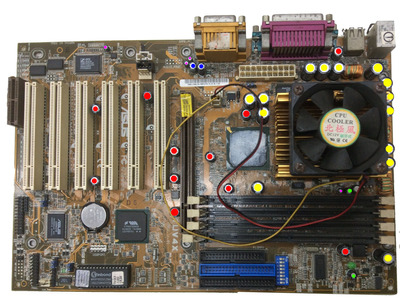mockingbird wrote on 2021-11-04, 19:50:I'm not generally a fan of polymer modding where it's not absolutely necessary. Sure, you can get polymer capacitors for very l […]
Show full quote
gabimor wrote on 2021-11-04, 18:42:
<snip>
I'll try to do a full polymer recap, cause I think it's a cool idea.
I'm not generally a fan of polymer modding where it's not absolutely necessary. Sure, you can get polymer capacitors for very little nowaday, but they are only 2000 hour parts... Whereas, they now have electrolytics that are 5000-10,000 hour rated. Long-life polymers OTOH are very, very expensive. Also, not all polymers are created equal. If you buy polymer caps from China or some other dubious source, open the capacitor up and check the quality of the polymer material. If it's white, dry, and flaky, then the cap is garbage. The polymer material should look shiny and black, and the concentric circle defining the roll should look tight and methodical.
Please, I would like to ask one more thing. […]
Show full quote
Please, I would like to ask one more thing.
Using a multimeter, I found caps using 12v, 2.5v, 5v and etc.
It's a GA-8IPE100 Pro, that I dessolded some bulged caps tomorrow.
Do I need to install CPU and RAM to measure the voltages of the caps?
I just turned on the motherboard and noted the voltages, but I found very low values in the VRM area, something about 0.03v.
I don't know, that's a good question. It sounds like it. If you're afraid you'll short something, solder a wire from the positive test point so that you can measure it at a safe distance.
I'm located in Brazil, and it's not possible to buy caps in Mouser, cause the shipping fee it's to expensive.
Fortunately, I found Chemi-com and Sanyo, in a specific place, but all the 820uf available are 2.5v, so I'll have to buy the 3300uf replacements in another shop.
Don't buy Chemi-Con and Sanyo from your local shop! They are either going to be general purpose capacitors which are not suitable for this application, or counterfeit. Sanyo hasn't made capacitors in years, they sold their capacitor business to Suncon (I do not recommend Suncon WG or WX series). Also, don't buy caps from eBay.
Send me a PM with specific details on the caps, I can hook you up with good prices and reasonable shipping.
One last thing, the TUV4X motherboard - which capacitors do you have installed in the VRM high and low there? It looks like Nichicon HD series -- is that right? If it's Nichicon HD series, then leave it alone.
I'm learning so much today, with you, and searching around the web!!
Well, I understood what you sad about full polymer recap.
I have a collection with around 60 working motherboards, and I'm afraid of losing the oldest ones, due to caps failure.
That's why I'm thinking about trying to do only one or two full polymer recaps, for testing and learning about.
Looking at my x3 TUV4X motherboards (not 4), I'm considering leave it alone at this moment, case the caps looks really reliable.
In the VRM area, yes, it's Nichicon, but I can't remember if it's HD series. I think it is.
There are rubycon caps too, around the motherboard.
Funny that I found, in the PCI area, some OST caps, which looks the same values of the rubycon one. I'm talking about 1000uf@6.3v.
Looks like there are two brands with the same values. 😀
Again, I understood what you said, but I think about trying only one recap with some Gigabyte motherboard, cause I'm seeing bloated caps in 3 or 4 motherboards.
I have 2 brand new GA-7N400, and about 6 bloated Sanyo 1000uf@6.3v, the green ones. Is it a bad series cap?
For me, if 6 are bloated, the other ones of the same spec will probably fail, sooner or later.
I already mapped the caps of this motherboard, but my first choice to recap is the GA-7VT600.
I'll map the caps and then, with your help, I'll try to find some good caps.
If you're saying the Sanyo and Chemi-con, from my local store, aren't a good choice, I'll avoid it!
You're, probably wright. 😀
Oh, I have a question:
If I buy a cap from China or another source, can I consider it's reasonable good, if the measured capacitance and ESR of the caps are ok?
I'll buy an ESR meter....
Thank you for helping me!


